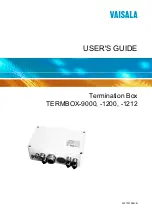
10.4.3
DHCP Options Set
Choose the menu
Routing→DHCP Server→
DHCP Options Set
to load the following page.
Netbios Node Type:
Specify the Netbios type for the clients, which is the way of
inquiring IP address resolution. The following options are
provided:
b-node Broadcast: The client sends query message via
broadcast.
p-node Peer-to-Peer: The client sends query message via
unicast.
m-node Mixed: The client sends query message via broadcast
first. If it fails, the client will try again via unicast.
h-node Hybrid: The client sends query message via unicast
first. If it fails, the client will try again via broadcast.
Next Server
Address:
Specify the IP address of a TFTP server for the clients. If
needed, the clients can get the configuration file from the TFTP
server for auto installation.
Domain Name:
Specify the domain name that the clients should use when
resolving host names via DNS.
Bootfile:
Specify the name of the bootfile. If needed, the clients can get
the bootfile from the TFTP server for auto installation.
option 60:
Specify the option 60 for device identification. Mostly it is used
under the scenario where the APs (Access Points) apply for
different IP addresses from different servers according to the
needs.
If an AP requests option 60, the server will respond a packet
containing the option 60 configured here. And then the AP will
compare the received option 60 with its own. If they are the
same, the AP will accept the IP address assigned by the server,
otherwise the assigned IP address will not be accepted.
option 138:
Specify the option 138, which can be configured as the
management IP address of an AC (Access Control) device. If
the APs in the local network request this option, the server will
respond a packet containing this option to inform the APs of
the AC’s IP address.
NTP Server:
Specify the Network Time Protocol Server for a client.
180
















































